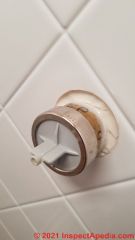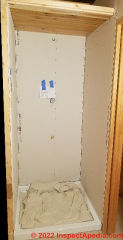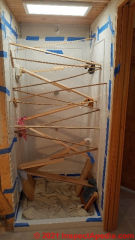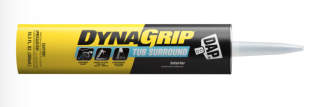 Right Adhesive for Tub or Shower Surround
Right Adhesive for Tub or Shower Surround
How to glue-up a plastic, vinyl, or fiberglass tub or shower surround enclosure
- POST a QUESTION or COMMENT about this article topic.
This article describes the proper adhesives to use in bathrooms to glue a tub or shower surround to the walls.
InspectAPedia tolerates no conflicts of interest. We have no relationship with advertisers, products, or services discussed at this website.
- Daniel Friedman, Publisher/Editor/Author - See WHO ARE WE?
Shower-Tub Surround Adhesive Choices
Watch out:
Some tub or shower surround materials will be partly-dissolved by the solvents in some adhesives, permanently damaging the tub surround and also making for a bulged, ugly installation. it is absolutely important to identify the specific materials used in your tub surround before buying and applying an adhesive to glue the tub surround to the wall surfaces.
Shown above are some adhesives recommended for "tub surrounds"; often these use polyurethane.
Dap's DynaGrip® Tub Surround construction adhesive, Loctite's PL-550® Tub Surround adhesive, and Liquid Nails® Tub surround and Shower Adhesive (polyurethane) are specifically formulated to be safe for the plastics or fiberglass surround products to be bonded to a wall. The proper adhesive also is a high-tack that helps mount the surround to the wall.
List of Tub or Shower Surround Adhesive Products
- Gorilla Heavy Duty Construction Adhesive
- LePage PL 700 Tub Surround Adhesive (Canadian product by Henkel)
- Liquid Nails® LN-915 Tub surround and Shower Adhesive
- Loctite's PL-550® Tub Surround adhesive (Henkel)
- Loctite PowerGrab adhesive
Which Adhesive Can be Used in Tub Surround Glue Jobs?
Typical adhesives for this purpose will not contain solvents that will cause damage to plastics. Those include
- Acrylic adhesive, water-based,e.g. Loctite PL® 550, Loctite PowerGrab adhesive, and others.
- Polyurethane adhesives, e.g. Gorilla Glue
- Synthetic latex adhesive, e.g. DAP Dynagrip® [actually Potassium tripolyphosphate and amorphous silica ]
Watch out: read the label on the adhesive you're buying to be sure it is acceptable for bonding tub or shower surrounds.
Some adhesive products will warn consumers specifically NOT to use that product on plastics such as tub surrounds.
Using the wrong adhesive risks using one that contains solvents that damage or dissolve the plastic tub or shower surround - it will be ruined.
Typical Tub/Shower Surround Glue-Up Instructions
 Photos here illustrate three stages during installation of a glued-up plastic shower surround. Similar procedures are used for both shower surrounds and tub surrounds.
Photos here illustrate three stages during installation of a glued-up plastic shower surround. Similar procedures are used for both shower surrounds and tub surrounds.
We show a water-resistant drywall enclosing the shower stall, a forest of flexible lath strips used to press the plastic dead flat against the drywall during gluing, and the very nice results after the adhesive had dried.
DAP's DynaGrip® Tub Surround Adhesive Instructions
Given here an example of how to glue up the tub or sower surround:
- Surfaces must be clean, structurally sound, and free of debris.
- Pre-cut and fit materials before applying adhesive.
- Trim nozzle to desired bead size. ¼” recommended for most applications.
- Puncture inner foil seal. [A typical caulk gun includes a swing-out wire or rod for this purpose]
- Load cartridge into applicator gun.
- Apply a continuous bead to studs or backer substrate, adhesive may also be applied to back of tub surround panel according to tub surround manufacturers installation instructions.
- Within 10 minutes, position and press panels firmly into place.
Watch out: if you blob on the adhesive and then wait too long to press the panels in place, the dry adhesive will actually hold the panel off of the wall surface and will give a bumpy, ugly, poorly-adhered job.

- Allow to dry for 24 hours before exposing to water or moisture.
Our photos show a plastic shower surround that we installed last year; we took care in selecting the adhesive and also in cross-bracing to be sure that the surround would bond dead flat to the drywall surfaces.
Really? Is all that cross-bracing necessary? Not necessarily, though Loctite acknowledges that "some applications will require bracing" without being more-specific.
If you follow the tub or shower surround adhesive instructions you apply it to the wall - or to the surround back surface, wait a bit for the adhesive to become tacky, then press the surround in place.
Really? Well in my experience, especially with tub or shower surround materials that are themselves rather thin and flexible, if you don't use extensive bracing like in my photos, you're going to have slight bulges and loose areas in the surround after the adhesives have cured. That may not look nice.
I don't like a shower or tub surround that moves when you press on it. And in particular, a tub or shower surround that moves in the area near plumbing penetrations is more-likely to leak in the future as it may break sealant you've applied there.
So I jammed all those little furring strips as springs to hold the walls in place until the "tub surround" (in this case a shower) adhesive had dried soundly.
Typically you've got about 10 minutes of working tie after applying your tub / shower surround adhesive.
 By applying the adhesive and then not waiting the full "tacky" time prescribed by the manufacturer, I had even more time to be certain that all three shower sides were aligned perfectly.
By applying the adhesive and then not waiting the full "tacky" time prescribed by the manufacturer, I had even more time to be certain that all three shower sides were aligned perfectly.
But putting them up a bit early I found that the plastic was not sitting dead flat on the walls. Hence all that crazy cross-bracing.
In sum, using sprung-wood fixtures to press the plastic shower surround against the walls isn't necesssary if you follow the adhesive manufacturer's instructions to
- apply the adhesive,
- press the plastic in place, then
- pull it away and allow the adhesive to dry just enough to become tacky-enough to hold the plastic in place
- then it is again pressed against the drywall.
If you wait too long before pressing up the plastic tub/shower panel, the adhesive won't bond at all and you've ruined the installation by leaving lumpy dried adhesive on the back of the plastic.
And if you don't wait long enough, the plastic surround sections won't bond securely to the drywall - leaving loose areas or even slight bulges in the tub or shower-surround walls.
Our approach, though klutzy-looking, was 100% effectiv at giving a dead-flat, perfectly-adhered glue-up of the shower surround to the drywall.
What Materials can Tub Surround Adhesives Glue?
Tub surround adhesives will glue most bath or tub wall materials to drywall or plywood or to a cement backerboard, as well as directly to framing lumber.
Using DAP's DynaGrip® as an example you'll see that a typical tub or shower enclosure adhesive can handle a range of materials including:
- ABS Tub Surrounds
- Acrylic Tub Surrounds
- Cement Backerboard
- Ceramic Tiles
- Dimensional Lumber
- Drywall (including "greenboard" or moisture-resistant or mold resistant drywall
- Fiberglass Tub Surrounds
- Foam back Tub Surrounds
- Greenboard
- OSB
- Plywood
- PVC Tub Surrounds
Note that the glued-to surfaces should be clean and dry.
Watch out: however these adhesives are NOT recommended for
- Mirror installations (gluing a mirror to a wall)
- Bonding two non-porous substances together (like glass to glass)
- As a sealant, such as applications other than gluing up a tub or shower surround
Don't Forget to Seal Penetrations in the Shower Surround Wall
Watch out: don't forget to seal around any openings you cut into your tub or shower surround before mounting the controls. Shown below: the "green cabin" shower control sealed in place.
While some shower controls are self-sealing to the shower control surround surface, when the surface has embossed grooves or ridges like the one shown here, there is some risk of water leaks behind the shower surround and into the building wall where it invites mold contamination, rot, or insect attack.
We used a white silicone caulk to seal our two penetrations in this shower surround wall. To be sure that the silicone sealant would bond well to the plastic shower surround and to the brass shower control body we wiped those surfaces with alcohol to remove any trances of oil or grease.
On 2020-07-16 by (mod) - be sure to choose the proper adhesive for tub or shower surround installation
Jolene:
When buying your adhesive, also look at the details on the adhesive tube, for wording that makes plain that the specific product you're buying is approved for and safe for use on plastics, fiberglass or other tub surround materials.
Do not buy generic "liquid nails" or some other general-purpose construction adhesive. That's where the brand name "Liquid Nails" can be confusing.
Some construction adhesives including "liquid nails" will damage plastic components like a tub or shower surround, but the Liquid Nails company also produces a "Liquid Nails" White Tub Surround and Shower Adhesive, Model # LN-715, shown just below. That product is ok to use for gluing up a tub or shower surround.

On 2020-07-16 by jolene
tub surround - what do I use to stick it up?
This Q&A were posted originally at
GLUES ADHESIVES, EXTERIOR CONSTRUCTION
References & Instructions for Tub or Shower Surround Adhesives
- DAP DYNAGRIP TUB SURROUND CONSTRUCTION ADHESIVE TECHNICAL DATA SHEET TDS [PDF] (2018) - retrieved 2021/05/07 original source: https://dap.com/products-projects/product-categories/adhesives/construction-remodeling/dynagrip-tub-surround/
Excerpt:
DAP® DYNAGRIP® TUB SURROUND construction adhesive is a premium grade, high strength adhesive specifically formulated for tub surround installation. This premium adhesive is safe for use on all tub surround materials and dries clear for an ideal finish. DYNAGRIP® TUB SURROUND is an instant grab adhesive that is moisture, steam, water, and heat resistance once fully cured. - GORILLA HEAVVY DUTY CONSTRUCTION ADHESIVE SAFETY DATA SHEET SDS [PDF] (2012) The Gorilla Glue Company
2101 E. Kemper Road
Cincinnati, Ohio 45241
513-271-3300
www.gorillatough.com retrieved2021/05/07 original source: https://www.gorillatough.com/wp-content/ uploads/ SDS-Update_Gorilla-Heavy-Duty-Construction-Adhesive-v1.2.pdf
Website excerpt:
Gorilla Heavy Duty Construction Adhesive is a tough, versatile, all-weather adhesive. The 100% adhesive formula provides a long-lasting, heavy duty bond. We call it All Surface, All Purpose*.
The gap-filling, durable, 100% waterproof adhesive formula is perfect for indoor and outdoor projects, holds in 30 seconds, and bonds virtually anything including subfloor, mirrors, trim, drywall, landscaping, bath surrounds, foamboard, marble and more!
...
Gorilla Heavy Duty Construction Adhesive is a tough and versatile adhesive. Its hybrid chemistry is formulated to bond a wide range of similar and dissimilar materials including most plastics, metals, elastomers, wood, and porous surfaces.
Certain difficult to bond plastics, such as polyethylene (PE) and polypropylene (PP), or certain types of rubber with high oil or plasticizer content will not form good bonds.
- LePage PL® 700™ TUB SURROUND ADHESIVE TECHNICAL DATA SHEET [TDS] [PDF] (2014) retrieved 2021/05/07 original source: https://dm.henkel-dam.com/is/content/henkel/tds -1421920-1442490 -ca-en-lepage-pl-700-tub-surround-adhesive-paper -cartridge-295ml-3xpaper- 1xplastic-cartridge-4x295mlpdf
- Liquid Nails LN915 TUB SURROUND & SHOWER WALL ADHESIVE TECHNICAL DATA SHEET TDS [PDF] (2015) retrieved 2021/05/07 original source: https://buyat.ppg.com/rep_pafpainttools_files/Liquid Nails US/LN-915_DataSheet_FINAL.pdf
- Liquid Nails LN915 tUB SURROUND & SHOWER WALL ADHESIVE MSDS [PDF] (2015) Op. Cit.
- LOCTITE PL® 550 TUB SURROUND CONSTRUCTION ADHESIVE TECHNICAL DATA SHEET [PDF] (2015) Loctite Brand is part of the Henkel family of brands. Headquarters - Rocky Hill, CT 06067
www.henkelna.com retrieved 2021/05/07 original source: https://dm.henkel-dam.com/is/content/henkel/TDS-1402263-US-Loctite-PL-550-Tub-Surround-Construction-Adhesive-Paper-Cartridge-10-fl-oz-2015-03-05pdf
Excerpts:
Loctite® PL® 550 Tub Surround Adhesive is specially formulated to bond most plastic bathroom and shower enclosures.
It is unaffected by moisture, steam, water, heat or cold when fully cured. PL 550 Tub Surround Adhesive will not harm or burn-through tub kit materials if used as directed. Low VOC formulation meets stringent State and Federal requirements.
PL 550 can be used for bonding most bathtub and shower surrounds (polystyrene, ABS and FRP panels) to waterproof drywall/greenboard drywall, drywall, or wood. For best results, at least one surface should be porous.
Application:
Apply the adhesive in a continuous vertical bead to the panel starting 1” (2.5 cm) in from the edge and continuing every 6” (15 cm) across the panel. Press the tub panel firmly to the wall within 10 minutes of applying the adhesive. Apply firm pressure across the entire panel surface to ensure good contact with adhesive.
Some applications will require bracing to maintain contact while curing. For best results, support the edges with masking tape. After 20 minutes hand press over all the areas of installation again to ensure good contact. Connect seams of panels according to tub surround manufacture instructions.
Seal the edges with caulking 24 hours after installation. When installing plumbing fixtures, do not allow plumber’s putty to be used where it may touch the polystyrene tub surround material as it may cause damage. Allow 24 hour cure time before using the area.
Clean-up:
Clean tools and any uncured adhesive residue with warm soap and water. Cured adhesive may be carefully cut away with a sharp-edged tool.
...
Continue reading at CAULKS & SEALANTS, EXTERIOR or select a topic from the closely-related articles below, or see the complete ARTICLE INDEX. Or see these
Or see these
Recommended Articles
- BATH & KITCHEN DESIGN GUIDE - home
- BATHROOM DESIGN, ACCESSIBLE
- BATHROOM VENTILATION CODES SPECS
- CAULKS & SEALANTS, EXTERIOR
- SPAS WHIRLPOOLS SOAKING & JETTED TUBS
- PLUMBING FIXTURES, KITCHEN, BATH - home
- TUB or SHOWER SURROUND ADHESIVE
- TUBS & TUB REPLACEMENTS or RELINERS
Suggested citation for this web page
TUB or SHOWER SURROUND ADHESIVE at InspectApedia.com - online encyclopedia of building & environmental inspection, testing, diagnosis, repair, & problem prevention advice.
Or see this
INDEX to RELATED ARTICLES: ARTICLE INDEX to BUILDING INTERIORS
Or use the SEARCH BOX found below to Ask a Question or Search InspectApedia
Or see
INDEX to RELATED ARTICLES: ARTICLE I NDEX to PLUMBING SYSTEMS
Or use the SEARCH BOX found below to Ask a Question or Search InspectApedia
Ask a Question or Search InspectApedia
Try the search box just below, or if you prefer, post a question or comment in the Comments box below and we will respond promptly.
Search the InspectApedia website
Note: appearance of your Comment below may be delayed: if your comment contains an image, photograph, web link, or text that looks to the software as if it might be a web link, your posting will appear after it has been approved by a moderator. Apologies for the delay.
Only one image can be added per comment but you can post as many comments, and therefore images, as you like.
You will not receive a notification when a response to your question has been posted.
Please bookmark this page to make it easy for you to check back for our response.
IF above you see "Comment Form is loading comments..." then COMMENT BOX - countable.ca / bawkbox.com IS NOT WORKING.
In any case you are welcome to send an email directly to us at InspectApedia.com at editor@inspectApedia.com
We'll reply to you directly. Please help us help you by noting, in your email, the URL of the InspectApedia page where you wanted to comment.
Citations & References
In addition to any citations in the article above, a full list is available on request.
- Our recommended books about building & mechanical systems design, inspection, problem diagnosis, and repair, and about indoor environment and IAQ testing, diagnosis, and cleanup are at the InspectAPedia Bookstore. Also see our Book Reviews - InspectAPedia.
- In addition to citations & references found in this article, see the research citations given at the end of the related articles found at our suggested
CONTINUE READING or RECOMMENDED ARTICLES.
- Carson, Dunlop & Associates Ltd., 120 Carlton Street Suite 407, Toronto ON M5A 4K2. Tel: (416) 964-9415 1-800-268-7070 Email: info@carsondunlop.com. Alan Carson is a past president of ASHI, the American Society of Home Inspectors.
Thanks to Alan Carson and Bob Dunlop, for permission for InspectAPedia to use text excerpts from The HOME REFERENCE BOOK - the Encyclopedia of Homes and to use illustrations from The ILLUSTRATED HOME .
Carson Dunlop Associates provides extensive home inspection education and report writing material. In gratitude we provide links to tsome Carson Dunlop Associates products and services.




